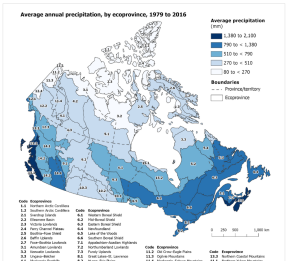
Average annual precipitation, by ecoprovince, 1979 to 2016, partial screen capture. Click on image for larger versions. Go to Statcan for the full map
Halifax area lakes are, collectively, incredibly well and in many regards, uniquely studied. It’s no coincidence. Flying east from central Canada – from the prairie provinces – one sees an ever increasing density and cover by lakes, culminating in Nova Scotia. That corresponds to precipitation patterns. NS (Nova Scotia), or the NS “Ecoprovince” is a very wet place!
…. amongst those is Sandy Lake, descibed in 1971 as “probably one of the finest fresh
water lakes in the Halifax-Dartmouth area”
Natural Environment Survey: A description of the intrinsic values in the natural environment around Halifax-Dartmouth
by P.B. Dean, Wildlife Biologist, Canadian Wildlife Service Dept. of Indian Affairs &Northern Dev. & D.B. Lister, Fishery Biologist, Resource Development Branch
Dept. of Fisheries &Forestry. April 1971. View Extracts related to Sandy Lake
Search Halifax area lakes are incredibly well studied
https://www150.statcan.gc.ca/n1/pub/11-402-x/2010000/chap/geo/tbl/tbl07-eng.htmTable 15.7 Land and freshwater area, by province and territory
Not highest by cover, Ontario and Manitoba,.but… by density,
Lakes in the Atlantic Provinces
The Atlantic provinces lie in a region of ancient mountains, a northern extension of the Appalachians. This land was also heavily glaciated. The many lakes in areas underlain by hard igneous or metamorphosed rocks closely resemble the lakes of the Shield. More permeable sedimentary rocks underlie eastern NB, northwestern NS and PEI; hence, fewer lakes occur in these areas. Many small coastal lakes occur in NS. https://www.thecanadianencyclopedia.ca/en/article/lake
Smallest and shallowest… exc Plains (slews etc)
A social-ecological geography of southern Canadian Lakes
https://www.researchgate.net/publication/369223337_A_social-ecological_geography_of_southern_Canadian_Lakes/link/64109dafa1b72772e4f94f6a/download
